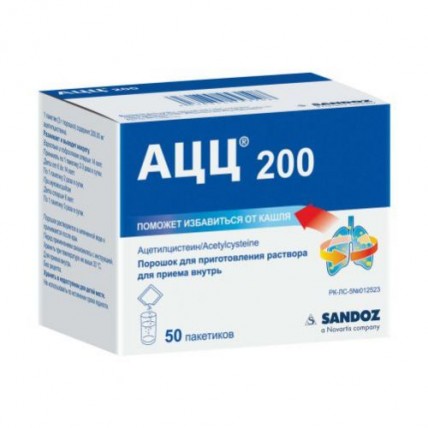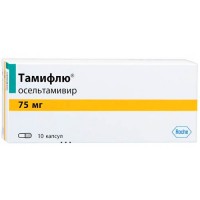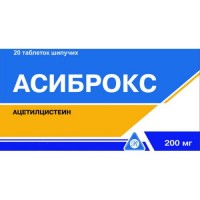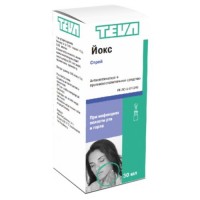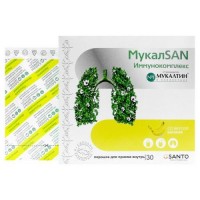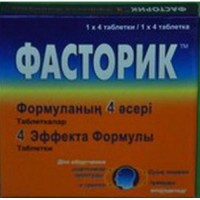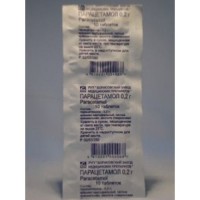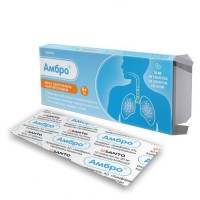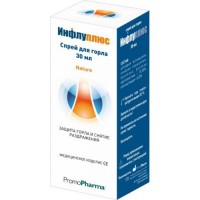ACC® 50s 200 mg powder for oral solution pack.
- $27.40
The instruction for medical use
of ACC 200 medicine
the Trade name
of ACC 200
the International unlicensed
name Acetylcysteinum Dosage Form Powder for preparation of solution for intake of 200 mg
Structure
1 bag contains 3 g of powder
active agent: Acetylcysteinum of 200 mg
excipients: sucrose, ascorbic acid, saccharin, fragrance orange dry 1:1000 Sotteri 289 **
(**-Essence of fragrance of orange 11.1%, anhydride of a dextrose of 82.7%, lactose of 6.2%)
the Description
the Homogeneous powder of white color which is not containing agglomerates of particles with an orange smell.
The restored solution - colourless, transparent or slightly opalescent.
Pharmacotherapeutic group
Drugs for elimination of symptoms of cold and cough.
Expectorant drugs. Mucolytics. Acetylcysteinum
the ATX R05 CB01 Code
The pharmacological
Pharmacokinetics Later properties of intake Acetylcysteinum is quickly absorbed from the digestive tract (DT) and metabolized in a liver in cysteine, pharmacological an active metabolite and also in diacetylcysteinum, cystine and various mixed disulfides.
Because of high effect of the first passing through a liver, bioavailability of Acetylcysteinum it is very low (about 10%).
At the person the maximum concentration in plasma are reached in 1-3 h. The maximum concentration in plasma of a metabolite of cysteine makes about 2 µmol/l. Linking of Acetylcysteinum with protein of blood plasma makes about 50%.
Acetylcysteinum is removed through kidneys almost only in the form of inactive metabolites (inorganic sulfates, diacetylcysteinum).
The semi-elimination period in plasma is about 1 hour and generally is defined by hepatic biotransformation. Therefore the abnormal liver function leads to prolongation of the plasma period of semi-elimination up to 8 hours.
The pharmacodynamics
Acetylcysteinum is derivative amino acids cysteine. Acetylcysteinum possesses sekretolitichesky and sekretomotorny action in airways. It breaks disulfide bridges between mukopolisakharidny chains and possesses the depolymerizing action on DNA chains (at a purulent phlegm). Thanks to these mechanisms the viscosity of a phlegm decreases.
The alternative mechanism of Acetylcysteinum is based on ability of its reactive sulfhydryl group to connect chemical radicals and it to neutralize them.
Acetylcysteinum promotes increase in synthesis of glutathione that is important for a detoxification of toxic agents. It explains its antidotal action in poisonings with paracetamol.
At its preventive use it has protective action concerning frequency and weight of exacerbations of bacterial infections that was established at patients with chronic bronchitis and a mucoviscidosis.
Indications
- sekretolitichesky therapy in acute and chronic diseases of bronchial tubes and lungs, the formations which are followed by disturbance and removal of a phlegm.
The route of administration and a dosage
of ACC 200 accept only in the form of the prepared solution, after a meal.
Adults and teenagers aged from 14 years are also more senior
On 1 bag of powder 2-3 times a day (there correspond 400-600 mg of Acetylcysteinum a day).
Children and teenagers from 6 to 14 years
On 1 bag of powder 2 times a day (there correspond 400 mg of Acetylcysteinum a day).
Duration of treatment depends on type and disease severity and has to be defined by the attending physician.
Solution preparation:
Powder is dissolved in a glass of boiled water and is accepted after a meal.
Other ACC forms are recommended to children under 6 years: ACC the junior, powder for preparation of oral solution, 20 mg/ml, ATsTs100, sparkling tablets, 100 mg or ATsTs200, sparkling tablets, 200 mg.
Side effects
not often (& ge, 1/1000, & lt, 1/100)
- allergic reactions (itching, urticaria, skin rash, a bronchospasm, a Quincke's edema)
- tachycardia
- arterial hypotension
- a headache
- fever
- stomatitis, an abdominal pain, diarrhea, vomiting, heartburn, nausea
- sonitus
Seldom (& ge, 1/10000, & lt, 1/1000)
- an asthma, a bronchospasm mainly at patients with hyperreactivity of the bronchial system connected with bronchial asthma
- dyspepsia
Very seldom (& lt, 1/10,000)
- the bleedings and hemorrhages which are partially connected with hypersensitivity reactions
- anaphylactic reactions, up to an acute anaphylaxis
- Stephens-Johnson's syndrome, a Lyell's disease
It is unknown
-
the Contraindication face edema
- hypersensitivity to any component of drug
- a peptic ulcer of a stomach and duodenum in an aggravation stage
- a pneumorrhagia, pulmonary bleeding
- bronchial asthma in an aggravation stage
- phenylketonuria
- children's age up to 6 years
- intolerance of fructose, a sprue of glucose galactose or sucrose-isomaltose
With care: gullet varicosity, bronchial asthma, diseases of adrenal glands, liver and/or renal failure, arterial hypertension.
Medicinal interactions
Simultaneous use of Acetylcysteinum and antibechics can cause dangerous secretory stagnation owing to reduction of a tussive reflex. For this reason this option of combination therapy has to be based on especially exact diagnosis.
For achievement of the best therapeutic effect the oral antibiotics (penicillin, tetracyclines and aminoglycosides) have to be entered separately, with a two-hour time interval. It does not concern a tsefiksim and a lorakarbef.
Use of activated carbon in high doses can weaken effect of Acetylcysteinum.
Simultaneous use of nitroglycerine and Acetylcysteinum should be carried out under control of the doctor as strengthening of vasodilating effect and inhibiting effect on aggregation of thrombocytes is possible.
Acetylcysteinum can influence colorimetric quantification of definition of salicylates.
Acetylcysteinum can affect results of the analysis of ketone bodies in the analysis of urine.
Special instructions
in case of changes from skin and mucous membranes the patient should stop immediately intake of Acetylcysteinum and to see a doctor.
Patients with bronchial asthma and obstructive bronchitis of ACC 200 should appoint with care under systematic control of bronchial conductivity because of risk of development of a bronchospasm.
Use of drug ACC 200 can lead to fluidifying of a phlegm in bronchial tubes and to some increase in its volume. At an insufficient tussive reflex it is applied: postural drainage or aspiration.
Patients with intolerance of a histamine should take the drug ACC 200 short courses, because of influence on metabolism of the histamine possible emergence of symptoms of intolerance (for example, a headache, cold, an itching).
1 bag contains 2.7 g of sucrose. It should be taken into account when prescribing drug ACC to 200 patients having diabetes.
Pregnancy and the period of a lactation
Use of drug ACC 200 during pregnancy and in the period of a lactation perhaps in cases if the expected advantage for mother exceeds potential risk for a fruit and the child though researches on animals did not reveal any straight line or indirect toxicity influencing pregnancy, embryonic and/or post-natal development.
The feature of influence of medicine on ability to run the vehicle or potentially dangerous mechanisms
does not influence.
Overdose
Symptoms: nausea, vomiting, diarrhea, is available for children risk of emergence of hypersecretion.
Treatment: symptomatic.
A form of release and packing
On 3 g in bags. On 20 or 50 bags together with the instruction for medical use in the state and Russian languages put in a pack from cardboard
Storage conditions
to Store at a temperature not over 30C.
To store out of children's reach!
4 years
not to use a period of storage after the expiry date specified on packing.
Prescription status
Without prescription
of Producer/Upakovshchik Lindopharm GmbH, Germany
the Owner of the registration certificate
of Hexal AG, Germany
the Address of the organization accepting in the territory of the Republic of Kazakhstan claims from consumers on quality of products (goods)
Representative office of JSC Sandoz Pharmasyyutikals of of in Republic of Kazakhstan, Almaty, Luganskogo St. 96,
Phone number: +7 727 258 10 48, fax: +7 727 258 10 47
e-mail:
Free number of dialing across Kazakhstan
To develop kzsdz.drugsafety@sandoz.com 8 800 080 0066
of ACC 200 medicine
the Trade name
of ACC 200
the International unlicensed
name Acetylcysteinum Dosage Form Powder for preparation of solution for intake of 200 mg
Structure
1 bag contains 3 g of powder
active agent: Acetylcysteinum of 200 mg
excipients: sucrose, ascorbic acid, saccharin, fragrance orange dry 1:1000 Sotteri 289 **
(**-Essence of fragrance of orange 11.1%, anhydride of a dextrose of 82.7%, lactose of 6.2%)
the Description
the Homogeneous powder of white color which is not containing agglomerates of particles with an orange smell.
The restored solution - colourless, transparent or slightly opalescent.
Pharmacotherapeutic group
Drugs for elimination of symptoms of cold and cough.
Expectorant drugs. Mucolytics. Acetylcysteinum
the ATX R05 CB01 Code
The pharmacological
Pharmacokinetics Later properties of intake Acetylcysteinum is quickly absorbed from the digestive tract (DT) and metabolized in a liver in cysteine, pharmacological an active metabolite and also in diacetylcysteinum, cystine and various mixed disulfides.
Because of high effect of the first passing through a liver, bioavailability of Acetylcysteinum it is very low (about 10%).
At the person the maximum concentration in plasma are reached in 1-3 h. The maximum concentration in plasma of a metabolite of cysteine makes about 2 µmol/l. Linking of Acetylcysteinum with protein of blood plasma makes about 50%.
Acetylcysteinum is removed through kidneys almost only in the form of inactive metabolites (inorganic sulfates, diacetylcysteinum).
The semi-elimination period in plasma is about 1 hour and generally is defined by hepatic biotransformation. Therefore the abnormal liver function leads to prolongation of the plasma period of semi-elimination up to 8 hours.
The pharmacodynamics
Acetylcysteinum is derivative amino acids cysteine. Acetylcysteinum possesses sekretolitichesky and sekretomotorny action in airways. It breaks disulfide bridges between mukopolisakharidny chains and possesses the depolymerizing action on DNA chains (at a purulent phlegm). Thanks to these mechanisms the viscosity of a phlegm decreases.
The alternative mechanism of Acetylcysteinum is based on ability of its reactive sulfhydryl group to connect chemical radicals and it to neutralize them.
Acetylcysteinum promotes increase in synthesis of glutathione that is important for a detoxification of toxic agents. It explains its antidotal action in poisonings with paracetamol.
At its preventive use it has protective action concerning frequency and weight of exacerbations of bacterial infections that was established at patients with chronic bronchitis and a mucoviscidosis.
Indications
- sekretolitichesky therapy in acute and chronic diseases of bronchial tubes and lungs, the formations which are followed by disturbance and removal of a phlegm.
The route of administration and a dosage
of ACC 200 accept only in the form of the prepared solution, after a meal.
Adults and teenagers aged from 14 years are also more senior
On 1 bag of powder 2-3 times a day (there correspond 400-600 mg of Acetylcysteinum a day).
Children and teenagers from 6 to 14 years
On 1 bag of powder 2 times a day (there correspond 400 mg of Acetylcysteinum a day).
Duration of treatment depends on type and disease severity and has to be defined by the attending physician.
Solution preparation:
Powder is dissolved in a glass of boiled water and is accepted after a meal.
Other ACC forms are recommended to children under 6 years: ACC the junior, powder for preparation of oral solution, 20 mg/ml, ATsTs100, sparkling tablets, 100 mg or ATsTs200, sparkling tablets, 200 mg.
Side effects
not often (& ge, 1/1000, & lt, 1/100)
- allergic reactions (itching, urticaria, skin rash, a bronchospasm, a Quincke's edema)
- tachycardia
- arterial hypotension
- a headache
- fever
- stomatitis, an abdominal pain, diarrhea, vomiting, heartburn, nausea
- sonitus
Seldom (& ge, 1/10000, & lt, 1/1000)
- an asthma, a bronchospasm mainly at patients with hyperreactivity of the bronchial system connected with bronchial asthma
- dyspepsia
Very seldom (& lt, 1/10,000)
- the bleedings and hemorrhages which are partially connected with hypersensitivity reactions
- anaphylactic reactions, up to an acute anaphylaxis
- Stephens-Johnson's syndrome, a Lyell's disease
It is unknown
-
the Contraindication face edema
- hypersensitivity to any component of drug
- a peptic ulcer of a stomach and duodenum in an aggravation stage
- a pneumorrhagia, pulmonary bleeding
- bronchial asthma in an aggravation stage
- phenylketonuria
- children's age up to 6 years
- intolerance of fructose, a sprue of glucose galactose or sucrose-isomaltose
With care: gullet varicosity, bronchial asthma, diseases of adrenal glands, liver and/or renal failure, arterial hypertension.
Medicinal interactions
Simultaneous use of Acetylcysteinum and antibechics can cause dangerous secretory stagnation owing to reduction of a tussive reflex. For this reason this option of combination therapy has to be based on especially exact diagnosis.
For achievement of the best therapeutic effect the oral antibiotics (penicillin, tetracyclines and aminoglycosides) have to be entered separately, with a two-hour time interval. It does not concern a tsefiksim and a lorakarbef.
Use of activated carbon in high doses can weaken effect of Acetylcysteinum.
Simultaneous use of nitroglycerine and Acetylcysteinum should be carried out under control of the doctor as strengthening of vasodilating effect and inhibiting effect on aggregation of thrombocytes is possible.
Acetylcysteinum can influence colorimetric quantification of definition of salicylates.
Acetylcysteinum can affect results of the analysis of ketone bodies in the analysis of urine.
Special instructions
in case of changes from skin and mucous membranes the patient should stop immediately intake of Acetylcysteinum and to see a doctor.
Patients with bronchial asthma and obstructive bronchitis of ACC 200 should appoint with care under systematic control of bronchial conductivity because of risk of development of a bronchospasm.
Use of drug ACC 200 can lead to fluidifying of a phlegm in bronchial tubes and to some increase in its volume. At an insufficient tussive reflex it is applied: postural drainage or aspiration.
Patients with intolerance of a histamine should take the drug ACC 200 short courses, because of influence on metabolism of the histamine possible emergence of symptoms of intolerance (for example, a headache, cold, an itching).
1 bag contains 2.7 g of sucrose. It should be taken into account when prescribing drug ACC to 200 patients having diabetes.
Pregnancy and the period of a lactation
Use of drug ACC 200 during pregnancy and in the period of a lactation perhaps in cases if the expected advantage for mother exceeds potential risk for a fruit and the child though researches on animals did not reveal any straight line or indirect toxicity influencing pregnancy, embryonic and/or post-natal development.
The feature of influence of medicine on ability to run the vehicle or potentially dangerous mechanisms
does not influence.
Overdose
Symptoms: nausea, vomiting, diarrhea, is available for children risk of emergence of hypersecretion.
Treatment: symptomatic.
A form of release and packing
On 3 g in bags. On 20 or 50 bags together with the instruction for medical use in the state and Russian languages put in a pack from cardboard
Storage conditions
to Store at a temperature not over 30C.
To store out of children's reach!
4 years
not to use a period of storage after the expiry date specified on packing.
Prescription status
Without prescription
of Producer/Upakovshchik Lindopharm GmbH, Germany
the Owner of the registration certificate
of Hexal AG, Germany
the Address of the organization accepting in the territory of the Republic of Kazakhstan claims from consumers on quality of products (goods)
Representative office of JSC Sandoz Pharmasyyutikals of of in Republic of Kazakhstan, Almaty, Luganskogo St. 96,
Phone number: +7 727 258 10 48, fax: +7 727 258 10 47
e-mail:
Free number of dialing across Kazakhstan
To develop kzsdz.drugsafety@sandoz.com 8 800 080 0066
